|
|
|
|
|
|
|
|
|
|
|
|
|
|
|
|
|
|
|
|
|
|
|
|
|
|
|
|
 |
 |
 |
 |
 |
 |
|
|
 |
 |
 |
|
|
|
 |
 |
 |
| In order to find this glass that I love, I have had to ask dealers this try-and-take-a-breath-in-here-somewhere question: |
|
| Do you have any of that glass which looks lavender in daylight or in incandescent light and then turns to a pale blue color in fluorescent lighting, and it is or was referred to as Alexandrit or Alexandrite by Moser Glassworks; as Wisteria by The Fostoria Glass Company; as Twilight (but not Twilite nor Wistaria) by Tiffin Glass Company and as Dawn, if made by Tiffin in Duncan & Miller molds but not Dawn, which is gray, if made by A. H. Heisey & Company, but instead as Alexandrite by Heisey ; as Wisteria by Steuben Glass Works; as Heatherbloom by The Cambridge Glass Company, but not all Heatherbloom; as Neo-Blue or Neodymium glass by Lotton Art Glass; as Alexandrite by Morgantown Glass Works; as Wisteria by Fenton Art Glass Company, but only that made in 1977 and 1978; as Alexandrite by Boyd`s Crystal Art Glass; as Pink Luxodine or Luxodin by the Czech glass company of ZBS (Zeleznobrodske Sklo A. S.), and it was used in costume jewelry by Weiss Company, Kramer of New York and many other jewelry companies here and in Europe, and those companies didn`t call it anything definitive at all? |
| Usually this question is followed by the dealers saying either that they have none or that they have no black light. After the fluorescent-is-not-black light issue is cleared up, 99% will still maintain that they have no glass like this (I go and look anyway), and 99% of the other 1% will happily show me pink glass, blue glass, lavender glass, and the ubiquitous amethyst glass, zero of which is the neodymium glass I seek. |
| HOWEVER, 1% of that last 1% will actually have a piece or two! It is enough to keep me searching and happy. (Well, that, and eBay.) |
|
 |
|
|
 |
 |
 |
|
|
|
 |
 |
 |
| I will be using the term "neodymium glass" throughout this article and it is meant to encompass all of this type of glass. When covering a specific company I will be using that company`s name for the glass. So it is no longer "neo-whatsis" glass (as my friend, Madolyn*, cleverly termed it) but now, neodymium glass. |
|
| The dichroic, (which means having or showing two colors), characteristic of neodymium glass is attributable to the use of neodymium oxide (Nd2O3) in the glass batch. Neodymium oxide has been referred to as a "rare-earth element" however it is actually a "rare-earth binary compound." If anyone wants the chemistry scoop regarding neodymium and all its properties, compounds and uses, there is always the encyclopaedia or toss the word into a search engine and VIOLA!---- 10,000 things to learn about neodymium, such as its discovery in 1885. |
|
| The dichroic nature of this glass is what, I think, makes it so interesting and desirable to collectors, and the scarcity of it keeps the prices on most pieces, very dear. Heisey, Morgantown, Tiffin, Fostoria and Cambridge are all now closed. Most of those companies made their neodymium glass for very limited periods. The U.S. companies still pressing it are making bibelots only, not table services, dinnerware and collateral pieces. Moser, ZBS and other European glass houses still make bowls, stems, vases and figurals. Contemporary art glass companies, such as Lotton Art Glass, are making lovely hand-blown decorative pieces. However, it is becoming difficult to find the pieces made from the 30s through the 50s by the famous, old U.S. companies. |
|
| Morgantown appears to have had the shortest production period and produced only a small number of items in its Alexandrite. I was told that at the recent Morgantown convention, not even one piece in Alexandrite was to be found for sale. Heisey and Fostoria had production periods for their neodymium glass of approximately 5 to 7 years. Steuben had discontinued production of its colored glassware by 1934. Cambridge introduced its Heatherbloom in late 1931 and it appears that by 1936 the color was no longer in production. Tiffin made its Twilight mostly in the 50s. I will be covering some additional information about many of these companies, in the following paragraphs. |
|
|
|
 |
|
|
 |
 |
 |
 |
 |
 |
 |
 |
 |
 |
 |
 |
 |
 |
 |
 |
 |
 |
 |
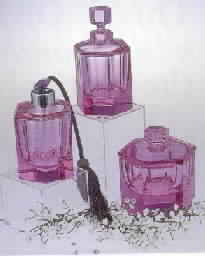 |
 |
 |
 |
 |
 |
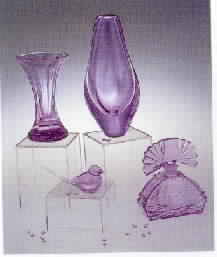 |
|
|
 |
 |
 |
 |
 |
 |
 |
 |
 |
 |
 |
 |
 |
 |
 |
 |
 |
 |
 |
 |
 |
|
 |
 |
 |
 |
 |
 |
 |
|
|
|
 |
|
|
|
 |
 |
 |
| The development of neodymium glass is attributed to Leo Moser, of Moser glass, in collaboration with Professor Quasebart of Berlin and Professor Turner of Sheffield, England, around 1920. It is reported that Heisey obtained the rights to produce this glass directly from the Moser company. Moser still produces its Alexandrit glass, and new pieces are moderately priced. Its pieces from the early production periods, when the Moser family still had ownership interest in Moser Glassworks, are commanding high prices. Moser used additional rare-earth compounds along with neodymium oxide to produce other dichroic glass, notably Heliolit, which changes from an amber-brown to green. Moser referred to all and any of this glass-type as "rare-earth doped" glass. Photo #1 shows a Moser vase, two items from ZBS and a perfume bottle from an unidentified Czech company, all fairly recent. Photo #2 shows a large and elegant Moser three-piece vanity set from the 50s (or could be more recent.) The perfume bottle is 7 ½" tall, the atomizer 5 ½" and the dresser jar 5". For pictures of the older Moser Alexandrite and the intriguing history of the company, I recommend Gary D. Baldwin`s book "Moser Artistic Glass, Edition Two". |
|
| Photo #1 shows, clockwise from upper left: (1) Moser, flared, faceted, vase. 6". $200. |
| (2) ZBS, ovoid, heavy, blown, vase. 9". $60. |
| (3) Czech perfume w. stopper. 5 7/8". $60. |
| (4) ZBS, bird figure, swallow. 2". $35. |
| |
| The values suggested here and in the following descriptions are either the price I paid for an item or prices realized on eBay. I share them only to give the reader some idea of value. Due to any number of factors, actual prices vary greatly. |
|
| The loose stones of this glass scattered throughout the photos are used in making costume jewelry. Marked pieces from well-known manufacturers such as Kramer of NY, Eisenberg, Weiss, & Vogue are very collectible. |
| Photo #3 shows: |
| (1) Kramer of N.Y flower shaped earrings.$25 (2) Kramer of N.Y. butterfly necklace. $50 (3)Weiss bracelet and earring set. $200 |
| (4) Czech necklace, faceted stones set in |
| silver. 18". 1930s. $200. |
|
|
|
|
|
|
 |
|
|
 |
 |
 |
 |
 |
 |
 |
 |
 |
 |
 |
 |
 |
 |
 |
 |
 |
 |
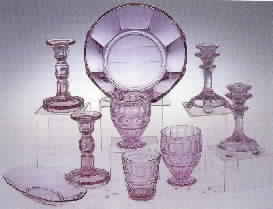 |
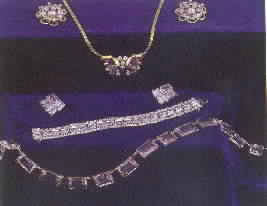 |
|
|
 |
 |
 |
 |
 |
 |
 |
 |
|
 |
 |
 |
 |
 |
 |
 |
 |
 |
 |
 |
 |
 |
 |
 |
 |
|
|
|
 |
 |
 |
 |
|
|
|
 |
 |
 |
| Fostoria introduced its Wisteria color in 1931 and offered it in many stemware, giftware and tableware lines. Most of the Wisteria production had ceased by 1938. I had a #2424 Kent 9 ½" flared bowl in my unidentified file for two years. I saw a drawing of the bowl in the book, "Fostoria Tableware 1924-1943, The Crystal for America" by Milbra Long and Emily Seate. An exchange of e-mail with Ms Seate confirmed that this item was made in Wisteria and would be so listed in a future book. I have found reference to more than thirty lines in which some, if not all, pieces were produced in Wisteria. The following lines appear to be the easier ones to find: #2440 Lafayette and #2449 Hermitage, and in stemware, #5098, #5099, #6003, and #6004. Fostoria never decorated its Wisteria glass so clear crystal decorated bowls are found on pieces with Wisteria bases and Wisteria bowls are found on clear crystal decorated bases in some stemware and other items. |
| |
| Even though Wisteria production was long in the past by 1977, Fostoria again used Wisteria for the "Designer Collection" line in 1977-1978. These vase collections were called Impressions, Images, and Interpretations. (A fourth line, Impromptu, is known, but I could find no pictures of it.) These were individually crafted art glass pieces in several shapes. These lines were all designed by the well known glass artist and designer, James Carpenter. Which shapes were made in Wisteria is difficult to determine because the color used by the artists who made the actual pieces was theirs to choose. Photo #5 pictures the two which I have. Fostoria had such a prolific production history and a wonderful wide range of table services, dinnerware and giftware that it is relatively easy to find Fostoria`s lovely Wisteria. |
| Photo # 4 shows: |
| (1) #2407 ½ candlesticks. 6". $150. (right side) |
| (2) #2424 Kent bowl, flared. 9 ½". $150.(upper center) |
| (3) #2449 Hermitage candlesticks. 6". $140.(left side) |
| (4) Two #2449 Hermitage footed table tumblers, 9oz. |
| 4 1/8". $20 each. (middle) |
| (5) #2449 Hermitage old fashioned cocktail glass, 6oz 3 ¼". $25.(lower middle) |
| (6) #2440 Lafayette pickle dish. 9 1/8" length $25. (lower left) |
|
| I think this is the first time a photo of the Kent bowl in Wisteria has been published. As you can see, it is a spectacular piece. |
|
| Some of Fostoria`s lines were exclusively vases, and I have seen only one ever offered for sale in Wisteria. It was a 6 ½" #2428 vase and it sold for $355! I also saw a pair of Wisteria #2447 Duo candlesticks sell recently for $222.50. I know I said it was easy to find Wisteria but I didn`t say it was always easy to purchase it. |
|
 |
|
|
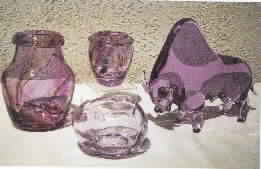 |
 |
 |
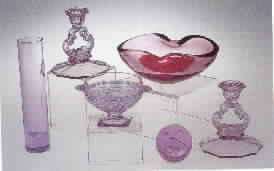 |
|
|
 |
 |
 |
 |
 |
 |
 |
 |
 |
|
 |
 |
 |
 |
 |
 |
 |
 |
 |
 |
 |
 |
 |
 |
 |
 |
|
|
|
 |
 |
|
|
|
 |
 |
 |
| Cambridge introduced its Heatherbloom in late 1931. It was last advertised in 1935. There were two kinds of Heatherbloom made, one with neodymium oxide in the batch and one without it. Naturally, the one without neodymium oxide is not dichroic. I read in one of my references that most Heatherbloom items which did not change color were marked so that it was not a problem in identifying them. That has not been my experience, though. What I have found is that most collectors who love Heatherbloom collect it for its beauty and whether it changes to pale blue or not is not particularly significant to them. Of course it is significant to the neodymium glass enthusiast. The line I see most often is Mount Vernon. It looks like cut glass and is very pretty in Heatherbloom. I have seen references to the following items or lines in Heatherbloom: #646 candlesticks, #3400 line in several etchings, Martha Washington, #3011 Statuesque, #3035, #3126, #3121, and #496. Three pieces are shown in Photo #6. |
|
| Neodymium glass has probably been produced in almost every glass-making country that exists. I have an Italian piece with neodymium glass surrounding a red center, a technique referred to as "Sommerso." My other Italian piece is a monumental bull figural (See Photo #5). It was made by Licio Zanetti. It is 12" in length, 9" high, 4" wide and weighs six pounds. My husband gave it to me for our ninth wedding anniversary. |
|
| I also have two examples of Swedish neodymium glass. Both the bubble optic paperweight and the cylindrical bud vase are from 1969. |
|
| Photo #6 shows: |
| (Top row) (1) Cambridge #646 Keyhole candlestick. 5 ½". |
| (2) Italian Sommerso bowl. 8" length. $80. |
| (Front row) (3) Swedish bud vase. 8". $25. |
| (4) Cambridge Mt. Vernon sugar. 3 3/8". $35. |
| (5) Swedish bubble optic paperweight. 2". $25. |
| (6) Mate to the #646 candlestick above. Pr. $200. |
|
|
|
|
 |
|
|
 |
 |
 |
 |
 |
 |
 |
 |
 |
 |
|
|





